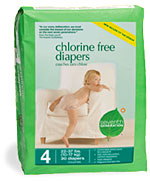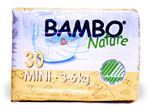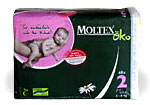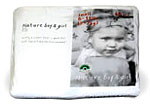
We got you covered.
After having my first child this summer, I learned one thing right off the bat: The only thing I craved more than a good, long nap was a good, strong nappy. I had heard tales from other parents of astronomical blowouts, but not until I was faced with my own filial feces did I appreciate the wonders of a reliable diaper.
In search of a green choice — and having passed up the cloth option for reasons I won’t go into here — I loaded up on the various “eco” disposables available, their claims ranging from chlorine-free materials to compostable packaging to strict manufacturing standards. For weeks, I subjected my wee one’s bum to these sustaina-swaddles, polling my partner and other diaper-changers for their reactions as well.
As often happens with eco-products, I stumbled into a hornets’ nest; this time, the controversy is over the superabsorbent gel that all but one of the brands use. Depending whom you ask, this gel is either a non-toxic way to keep baby bums dry or a chemical irritant that poses an array of possible health hazards. (The Green Guide has a useful, non-shrill rundown of this and other diaper-related issues.)
With that in mind, I did my best to test not only how the diapers performed, but whether their claims held water. Here’s what I found.

Seventh Generation
Eco-claims: Chlorine-free, fragrance-free, latex-free
Performance: Stops poop in its tracks
Some people’s noses wrinkle at the unbleached look of this diaper — a color the company actually creates with special pigment in order to set the product apart. Drab though they be, these diapers work; I am grateful for the many times I followed a trail of poop up, up, up the back of the diaper, only to see it stopped in its tracks at the waistband. In typical Seventh Generation style, the packaging is prose-heavy, explaining that “our extensive research on [absorbent polymer gel] has shown that it is non-toxic and safe for babies while helping keep them dry and comfortable.” The company also says it is working to improve the sustainability of its diapers.

Bambo Nature
Eco-claims: Environmentally friendly state-of-the-art raw materials, chlorine-free, no optical brighteners or perfume
Performance: An all-around cham-pee-on
These Denmark-derived diapers dominate the field, at least where my baby’s bum is concerned. They’re on the thicker side, but the size was right, the designs (turtles and zebras and kitties, oh my!) were bearable, and we didn’t have a single leak or blowout episode. The company doesn’t make any sound-bite eco-claims, but it does go to great lengths on its packaging to explain every material used (“elastication made from elastothane”). Both its materials and practices have earned it the Nordic Ecolabel, and since I’m a firm believer in the moral superiority of Scandinavia in general, I buy it. If only that pesky ocean weren’t in the way — these nappies aren’t available in the U.S., and trans-Atlantic shipping just doesn’t seem right.

Moltex ÖKO
Eco-claims: “So natürlich wie Ihn Kind!” (“As natural as a child!”); chlorine-free absorbent core, contains over 50 percent renewable resources, compostable packaging
Performance: Large and in charge
It took me a couple of days to identify the smell these diapers — another European offering — emitted when wet, and then it hit me: shredded wheat. Whether or not they bear any actual connection to the breakfast cereal is unclear; another brand contains wheat starch, but I couldn’t confirm the contents of these. Still, both the packaging and the diaper itself are said to be compostable — although diaper composting is not without its own controversy — and there is “minimal” gel inside. I found that the diapers held messes well, presumably because of their generous proportions; or, as my partner put it, “Because they go up to his freakin’ nipples.”

Nature Boy & Girl
Eco-claims: Backsheet made of corn-based material, uses less superabsorbent gel
Performance: Leaves something to be desired … sometimes on your leg
This Renton, Wash.-based company sells a diaper created in Sweden. It uses “channel construction” that requires less superabsorbent gel, and the outside of the diaper is made from a corn-based plastic that is touted as breathable. I wanted to love this “diaper for the twenty-first century,” but the corn plastic shredded a bit around the edges and its texture brought suffocation to mind. (The rest of the diapers are plastic too, but their “cloth-like feel” is quite convincing.) Overall, the diaper didn’t live up to my dreams. In fact, nearly every poop escaped — I won’t even tell you about the one that ended up oozing onto my hand.

Earth’s Best / TenderCare
Eco-claims: Chlorine-free, latex-free, dye-free, perfume-free
Performance: Yeah, Earth’s Best, if “best” means “averagest”
In a curious tale of diaper evolution, Earth’s Best just added TenderCare diapers to its extensive product line. The two share billing on the packaging — which touchingly includes instructions on how to diaper a child — but TenderCare is still sold under its own name as well. Both companies are owned by Hain Celestial, as is Tushies (see below); a representative at TenderCare told me that as far as she knows, all three brands will continue to coexist. The TenderCare diapers are a solid performer, but the Earth’s Best that I bought were stiff and occasionally leaky. Maybe a bug in the manufacturing process — I’d let these ripen before I tried them again.

Whole Foods 365
Eco-claims: Chlorine-free, fragrance-free, latex-free, dye-free; wood pulp harvested from family-owned, responsibly managed forests
Performance: Solid, with a touch of suspense
The company’s private-label diaper, introduced two years ago, is produced by an undisclosed manufacturer (the packaging gives no hint, nor did the PR department when I called). It looks suspiciously like the TenderCare brand to me, and performed about the same — solid, with the occasional leak. Like Seventh Generation, Whole Foods addresses the gel issue right on the packaging, but this time I felt like I was being spun: “Super-absorbent gel helps to keep your little bundle of joy comfortable and dry, in the most ecologically conscientious way possible.”

Tushies
Eco-claims: Certified non-chlorine bleached wood pulp from Scandinavian sustainable, renewable, family-owned forests; no animal testing, ingredients, or byproducts; gel-free, latex-free, dye-free, perfume-free, TBT-free, GMO-free
Performance: Gel-free but not leak-free
Billed as the world’s only gel-free disposable, these diapers mix cotton into the inner padding to help with absorption. As a result, they’re slightly more bulky than the others, and — as the company freely admits — need to be changed more often. All of which would be fine, if not for the wimpy leg elastic that lets contents sneak out, and the tape that — unlike the readjustable hook-and-loop tabs on the other brands — is tough to unfasten. If you’re anti-gel and can’t do cloth, this is your best option, but performance-wise, it doesn’t shine.
The bottom line: If you’re wary of gel, Tushies are your only choice. Of the brands that use gel, U.S.-based Seventh Generation and Denmark-based Bambo performed the best. So how you handle continence may depend upon your continent.

